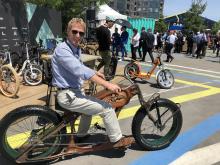
Digitalisation of transport systems, the regulation of new technologies and more charging points for electric vehicles in cities were among the talking points at this year’s Transport Research Arena conference. Alan Dron sifts through the highlights in Vienna
More than 3,000 transport sector specialists converged on TRA 2018, where the four-day event’s agenda included scores of topics covering regulation, technology and the effect of the digitalisation of road transport systems.
Who should control those systems was the subject of one debate. Sabine Kuehschelm, head of road infrastructure and traffic safety at Austria’s Federal Ministry for Transport, Innovation and Technology, said that private sector firms involved in connected and autonomous vehicle research, such as Google and Tesla, had urged the public sector to stand aside, so as not to over-regulate the sector.
However, she believed that only if national road authorities were involved was the public likely to have confidence in the new systems.
That was also the view of Clara de la Torre, transport director for the European Commission’s DG, Research and Innovation. “Connected and automotive driving is a game-changer,” she said. “It will have a great impact on both the economy and society…so the European Commission has to be there. We need framework conditions for those technologies to be deployed.”
However, she accepted that there was a ‘sweet spot’ in the degree of regulation, so that it did not stifle innovation.
Improving conditions
On the operational side, Mats Rosenquist, director of external research collaboration for
Technology and behaviour
New forms of battery power will be required for the more difficult forms of road transport, notably long-distance road freight movement, said Alan McKinnon, professor of logistics at Kühne Logistics University.
While once it had been thought that bio-fuels would solve the emissions problem, life-cycle tests had shown this to be unlikely. Current batteries were also not up to the job, but new types of batteries, perhaps hydrogen or even electrified highways – once thought of as science fiction – were possibilities.
Deciding which power source would work best was not simply a question of ‘letting the market decide’, because considerable infrastructure would need to be installed and that required political decisions. Future sustainable road transport required multiple aspects to be brought together, said McKinnon. Quoting former US vice president Al Gore, he said the problem would be solved not by a ‘silver bullet’ but by ‘silver buckshot’.
One of those pieces of buckshot had to be a change in consumers’ attitudes, said McKinnon. Research had shown that, used correctly, internet shopping could save carbon emissions: “As soon as you take a car trip out of the equation, it’s cutting carbon.”
However, people had to be made aware that ordering six garments for overnight delivery, then returning five of them, “is unsustainable”.
Digitalisation of transport systems was a major topic of debate at TRA 2018 - and concerns about this increasing automation were raised by several speakers, while others highlighted the potential advantages it could bring.
Those benefits included the increasing ability to combine data from several silos and build new services on top of them suggested Ahmed Nasr,
However, with digitalisation of transport systems already seeing control passing from humans to machines it is essential that those machines can take the correct decisions to ensure the systems’ security, said Nasr.
Further concerns were voiced by Georg Kapsch, CEO of Austria’s
That had been shown all too clearly a few years ago when a cyberattack on Ukrainian tax systems had sent ripples across much of Europe, explained Norbert Kouwenhoven, head of global trade digitalisation at IBM. That attack, for example, forced the port of Rotterdam to shut down its data system, costing it €800 million in lost business in just three days.
Seamless travel
However, Kouwenhoven hoped that in five to ten years’ time digitalisation would greatly aid seamless travel: it could mean that a motorist might drive across Europe with a single box in his or her car that would automatically handle all tolls and road charges, for instance.
Speakers were generally hopeful of the benefits that the digitalisation of road transport would bring. But one audience member queried how it would help those people who were unable, or unwilling, to use it. Millions of elderly people remained outside the digital word, while increasing numbers of young people were rejecting it.
There would always be a certain proportion of the population who could not participate in the new technologies, acknowledged Kapsch: “Those who are not able to do so, we have to care about - [but] those who don’t want to join I don’t think we have responsibility for.”
While the advent of widely-available autonomous vehicles would give consumers more travel options and greater opportunities for seamless transport, research in the US suggested that, as they became more readily available, they could attract commuters away from public transport – not the desired outcome if it resulted in more vehicles on city streets. “A car is a car,” commented one speaker.
However, there are non-technological methods of easing road congestion, Nasr told the audience. Research in the Netherlands had shown that 10% of early-morning rush hour traffic was due to elderly people driving to hospitals for medical appointments – therefore, changing the time of medical appointments could move road usage to an off-peak period.
Technology and behaviour
New forms of battery power will be required for the more difficult forms of road transport, notably long-distance road freight movement, said Alan McKinnon, professor of logistics at Kühne Logistics University.
While once it had been thought that bio-fuels would solve the emissions problem, life-cycle tests had shown this to be unlikely. Current batteries were also not up to the job, but new types of batteries, perhaps hydrogen or even electrified highways – once thought of as science fiction – were possibilities.
Deciding which power source would work best was not simply a question of ‘letting the market decide’, because considerable infrastructure would need to be installed and that required political decisions. Future sustainable road transport required multiple aspects to be brought together, said McKinnon. Quoting former US vice president Al Gore, he said the problem would be solved not by a ‘silver bullet’ but by ‘silver buckshot’.
One of those pieces of buckshot had to be a change in consumers’ attitudes, said McKinnon. Research had shown that, used correctly, internet shopping could save carbon emissions: “As soon as you take a car trip out of the equation, it’s cutting carbon.”
However, people had to be made aware that ordering six garments for overnight delivery, then returning five of them, “is unsustainable”.










